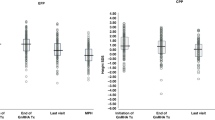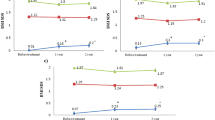Summary
The effect of obesity on idiopathic central precocious puberty (ICPP) girls is still under discussion. The relationship between body mass index (BMI) and sexual hormone levels of gonadotropin-releasing hormone (GnRH) stimulation test in ICPP girls is controversial and the underlying mechanism is unclear. This study aims to further explore the independent effect of excess adiposity on peak luteinizing hormone (LH) level of stimulation test in ICPP girls and the role of other related factors. A retrospective cross-sectional study was performed on 618 girls diagnosed as having ICPP, including 355 cases of normal weight, 99 cases of overweight and 164 cases of obese. The results showed that obese group had more progressed Tanner stage and no significant difference (P=0.28) in LH peak was found as basal LH value was used as a covariate. The obese group had higher total testosterone (TT), adrenocorticotrophic hormone (ACTH), 17-α hydroxyprogesterone (17-αOHP) and androstendione (AN), with significantly increased fasting insulin (FIN) and homeostasis model of assessment for insulin resistance index (HOMA-IR). Stratified analysis showed inconsistency of the relationship between BMI-standard deviation score (BMI-SDS) and LH peak in different Tanner stages (P for interaction=0.017). Further smoothing plot showed linear and non-linear relationship between BMI-SDS and LH peak in three Tanner stages. Then linear regression model was used to analyze the relationship between BMI-SDS and LH peak in different Tanner stages, with and without different confounding factors being adjusted. In B2 stage, BMI-SDS was negatively associated with LH peak. In B3 stage, when BMI-SDS <1.5, as BMI-SDS increased, the level of LH peak decreased (model I: β=–1.8, 95% CI=–4.7 to 1.1, P=0.214). When BMI-SDS ≥1.5, BMI-SDS was significantly positively associated with LH peak (model I: β=4.5, 95% CI=1.7 to 7.4, P=0.002). In B4 stage, when BMI-SDS <1.5, BMI-SDS was negatively associated with LH peak (model I: β=–11.6, 95% CI=–22.7 to–0.5, P=0.049). When BMI-SDS ≥1.5, BMI-SDS was positively associated with LH peak (model I: β=–4.2, 95% CI=–3.3 to 11.7, P=0.28). It is concluded that there is an independent correlation between BMI-SDS and LH peak of stimulation test in ICPP girls, their relationships are different in different Tanner stages, and the effect of BMI-SDS can be affected by adrenal androgens, estradiol and glucose metabolism parameters.
Similar content being viewed by others
References
Burt Solorzano CM, McCartney CR. Obesity and the pubertal transition in girls and boys. Reproduction, 2010,140(3):399–410
Latronico AC, Brito VN, Carel JC. Causes, diagnosis, and treatment of central precocious puberty. Lancet Diabetes Endocrinol, 2016,4(3):265–274
Carel JC, Léger J. Precocious Puberty. N Engl J Med, 2008,358(22):2366–2377
Brito VN, Latronico AC, Arnhold IJP, et al. Update on the etiology, diagnosis and therapeutic management of sexual precocity. Arq Bras Endrocrinol Metab, 2008,52(1):18–31
Neely EK, Hintz RL, Wilson DM, et al. Normal ranges for immunochemiluminometric gonadotropin assays. J Pediatr, 1995,127(1):40–46
Brito VN, Batista MC, Borges MF, et al. Diagnostic value of fluorometric assays in the evaluation of precocious puberty. J Clin Endocrinol Metab, 1999,84(10):3539–3544
Kaplowitz PB. Link between body fat and the timing of puberty. Pediatrics, 2008,121(3):S208–S217
Knudsen KL, Blank SK, Burt SC, et al. Hyperandrogenemia in obese peripubertal girls: correlates and potential etiological determinants. Obesity, 2010,18(11):2118–2124
Bordini B, Littlejohn E, Rosenfield RL. Blunted sleep-related luteinizing hormone rise in healthy premenarcheal pubertal girls with elevated body mass index. J Clin Endocrinol Metab, 2009,94(4):1168–1175
McCartney CR, Prendergast KA, Blank SK, et al. Maturation of luteinizing hormone (gonadotropin-releasing hormone) secretion across puberty: evidence for altered regulation in obese peripubertal girls. J Clin Endocrinol Metab, 2009,94(1):56–66
Pinhas-Hamiel O, Lerner-Geva L, Copperman NM, et al. Lipid and insulin levels in obese children: changes with age and puberty. Obesity, 2007,15(11):2825–2831
McCartney CR, Prendergast KA, Chhabra S, et al. The association of obesity and hyperandrogenemia during the pubertal transition in girls: obesity as a potential factor in the genesis of postpubertal hyperandrogenism. J Clin Endocrinol Metab, 2006,91(5):1714–1722
McCartney CR, Blank SK, Prendergast KA, et al. Obesity and sex steroid dhanges across puberty: evidence for marked hyperandrogenemia in pre-and early pubertal Obese Girls. J Clin Endocrinol Metab, 2007,92(2):430–436
Fu JF, Liang JF, Zhou XL, et al. Impact of BMI on gonadorelin-stimulated LH peak in premenarcheal girls with idiopathic central precocious puberty. Obesity, 2015,23(3):637–643
Giabicani E, Allali S, Durand A, et al. Presentation of 493 consecutive girls with idiopathic central precocious puberty: a single-center study. PLoS One, 2013,8(7):e70931
Li H Ji CY, Zong XN, et al. Body mass index growth curves for Chinese children and adolescents aged 0 to 18 years. Zhong Hua Er Ke Za Zhi (Chinese), 2009,47(7):493–498
Consensus statement for the diagnosis and treatment of central precocious puberty (2015). Zhonghua Er Ke Za Zhi (Chinese), 2015,53(6):412–418
Tanner JM, Marshall WA. Variations in pattern of pubertal changes in girls. Arch Dis Child, 1969,44:291–303
Greulich WW, Pyle SI. Radiologic atlas of skeletal development of the hand and wrist. Stanford University Press: Stanford, California,1959:91(1).
Brown RJ, Yanovski JA. Estimation of insulin sensitivity in children: methods, measures and controversies. Pediatr Diabetes, 2014,15(3):151–161
Xi B, Zhao X, Shen Y, et al. An obesity genetic risk score predicts risk of insulin resistance among Chinese children. Endocrine, 2014,47(3):825–832
Bucholtz DC, Chiesa A, Pappano WN, et al. Regulation of pulsatile luteinizing hormone secretion by insulin in the diabetic male lamb. Biol Reprod, 2000,62(5):1248–1255
Williams NI, Lancas MJ, Cameron JL. Stimulation of luteinizing hormone secretion by food intake: evidence against a role for insulin. Endocrinology, 1996,137(6):2565–2571
Hileman SM, Schillo KK, Hall JB. Effects of acute, intracerebroventricular administration of insulin on serum concentrations of luteinizing hormone, insulin, and glucose in ovariectomized lambs during restricted and ad libitum feed intake. Biol Reprod, 1993,48(1):117–124
Dong Q, Lazarus RM, Wong LS, et al. Pulsatile LH secretion in streptozotocin-induced diabetes in the rat. J Endocrinol, 1991,131(1):49–55
Sliwowska JH, Fergani C, Gawalek M, et al. Insulin: its role in the central control of reproduction. Physiol Behav, 2014,133:197–206
Blank SK, McCartney CR, Chhabra S, et al. Modulation of gonadotropin-releasing hormone pulse generator sensitivity to progesterone inhibition in hyperandrogenic adolescent girls-implications for regulation of pubertal maturation. J Clin Endocrinol Metab, 2009,94(7):2360–2366
McGee WK, Bishop CV, Bahar A, et al. Elevated androgens during puberty in female rhesus monkeys lead to increased neuronal drive to the reproductive axis: a possible component of polycystic ovary syndrome. Hum Reprod, 2012,27(2):531–540
Collins JS, Beller JP, Burt Solorzano C, et al. Blunted day-night changes in luteinizing hormone pulse frequency in girls with obesity: the potential role of hyperandrogenemia. J Clin Endocrinol Metab, 2014,99(8):2887–2896
Pielecka J, Quaynor SD, Moenter SM. Androgens increase gonadotropin-releasing hormone neuron firing activity in females and interfere with progesterone negative feedback. Endocrinology, 2006,147(3):1474–1479
Couse JF, Korach KS. Estrogen receptor null mice: what have we learned and where will they lead us? Endocr Rev, 1999,20(3):358–417
Gill S, Sharpless JL, Rado K, et al. Evidence that GnRH decreases with gonadal steroid feedback but increases with age in postmenopausal women. J Clin Endocrinol Metab, 2002,87(5):2290–2296
Welt CK, Pagan YL, Smith PC, et al. Control of follicle-stimulating hormone by estradiol and the inhibins: critical role of estradiol at the hypothalamus during the luteal-follicular transition. J Clin Endocrinol Metab, 2003,88(4):1766–1771
Shaw ND, Histed SN, Srouji SS, et al. Estrogen negative feedback on gonadotropin secretion: evidence for a direct pituitary effect in women. J Clin Endocrinol Metab, 2010,95(4):1955–1961
Lee HS, Yoon JS, Hwang JS. Luteinizing hormone secretion during gonadotropin-releasing hormone stimulation tests in obese girls with central precocious puberty. J Clin Res Pediatr Endocrinol, 2016,8(4):392–398
Author information
Authors and Affiliations
Corresponding author
Additional information
This study was supported by grants from 12th five-year Plan National Key Technology R&D Program (No. 2012BAI09B04) and Program for Changjiang Scholars and Innovative Research Team in University (No. PCSIRT1131).
Rights and permissions
About this article
Cite this article
Zhao, Y., Hou, L., Gao, Hj. et al. Independent relationship between body mass index and LH peak value of GnRH stimulation test in ICPP girls: A cross-sectional study. J. Huazhong Univ. Sci. Technol. [Med. Sci.] 37, 556–562 (2017). https://doi.org/10.1007/s11596-017-1772-2
Received:
Revised:
Published:
Issue Date:
DOI: https://doi.org/10.1007/s11596-017-1772-2




